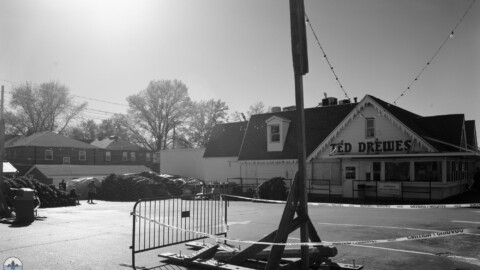
photo by Isaac Richardson
Baden is a former town on the northern border of St. Louis with an early history in the region. Situated with Broadway as a main artery, Baden benefited from this with a thriving commercial district and easy access to the industry located mostly to its direct south and east. Architecturally, the neighborhood features some remarkable structures, but the built environment is perhaps made even more interesting by the unusual street grid coursing through it.

photo by Monica Tirre

photo by Sue Rakers

photo by Dave Adams

photo by Jackie Johnson
St. Louis is a city where both history happens and history repeats itself. Baden is a neighborhood defined by this notion, yet bordering upon real change for itself (though hinging between the positive and negative gamut possible of that change).

photo by Jeff Phillips

photo by Mike Matney

photo by Jason Gray
The early origins of Baden are due to its location at the convergence of two former trails, one leading to what was once a principal, American military post for the region, called Fort Bellefontaine (the successor to a Spanish fort from the 1700’s), and another that led to a ferry that was central to trade with Indians, the westward migration of Americans, and even riverboat entertainment for the area of the time. After aligning in Baden, the trails formed the northern extension of Broadway, which led south directly into St. Louis’ Downtown, and beyond that, to the river town of Carondelet. Given the significance of these routes, it’s not surprising that Baden would form one of the oldest continuously used commercial districts originally outside of the city.

photo by Sue Rakers

photo by Ann Aurbach

photo by Jackie Johnson

photo by Dave Adams
In the first decades of the 19th Century, German immigrants began to pour into the St. Louis area in search of a new Rhineland. Hermann, a town central to Missouri winemaking and up the Missouri River from the Hall’s Ferry whose route led through Baden to St. Louis, is but one example of German settlers through the region. As immigration continued and increased in volume by mid-century, the Germans settled less and less often into the Missouri hinterland, and frequently choose to remain in or near St. Louis. The communities they formed, places like Baden and Hyde Park, persist in representing the basis for the northside’s built environment, and in some ways, the cultural legacies of many north St. Louis neighborhoods. Baden was officially christened around 1860 (though it never incorporated), but a thriving German village had existed there for some time before. In 1876, when St. Louis extended its border to its current position, Baden became a neighborhood of the city.

photo by Monica Tirre

photo by Joe Harrison

photo by Mike Matney
From walking through the neighborhood, it is obvious that much has changed in Baden in the time since 1876. Busy corridors, like Broadway, have been built and rebuilt enough that the street would be unrecognizable to most anyone who had lived or worked there more than 100 years ago. On the other hand, the neighborhood’s population well exceeds the 400 or so recorded before the city’s annexation. This also means that many of the neighborhood’s subdivisions were built much, much later, including the several streets of St. Louis’ signature “gingerbread cottages” that would rival, in terms of design and preservation, any of those found on the city’s southside.

photo by Dave Adams

photo by Joe Rakers
Today, the neighborhood sits on the verge of change. The previous decades have shown a declining population, but the last decade hints on items of real concern. Though the neighborhood, like most of the city, is primarily Black or White in terms of its racial makeup, Baden is losing its White population disproportionately to its Black. Part of this is an aging White populace for that whole far northside, but there is certainly more to the picture. Between 2000 and 2010, the neighborhood lost 55% of its White residents, which led a neighborhood that was 86% Black to begin with to swell to 92%. During the same time, the amount of vacant buildings went up by 18% and median income went down. All of this presents a problem for the neighborhood, which has seen several attempts at revitalization stutter and stop over recent years.
If nothing else, it is certainly a neighborhood of pretty extreme differences. In its southeastern portions and along Broadway, Baden is a bit rough around the edges, with some of its oldest properties in severe decline or even condemned. We ran into a woman in this section who asked why we would come there. “This place is hell,” she said. In addition, a member was yelled at to not take pictures, and some passing cars honked aggressively to try to disrupt images being made. At the same time, the northwestern side and parts of Riverview are seemingly thriving, and our members had several positive exchanges in these areas.

photo by Jason Gray

photo by Jeff Phillips

photo by Isaac Richardson
Map available here.
Our endpoint for Photo Flood 65 was London’s Wing House. Formerly known as London and Sons, the business that began over 50 years ago was re-conceived in 2010 by a subsequent generation of the founder’s family. The idea behind Photo Flood members meeting at a restaurant after the Floods was to encourage members to visit establishments that they may not otherwise, in the neighborhoods where they are photographing, and London’s is the epitome of why this strategy is so important. The food at London’s was great (the Chicken Sliders were soooo delicious!), and the staff were all very friendly and accommodating. We will definitely be back, and we highly recommend that all of our readers try one of the three locations of this iconic, locally-owned restaurant.

some Flooders in London’s, photo by Jason Gray






